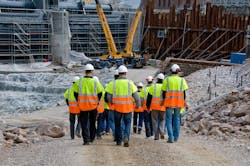OSHA’s Final PPE Rule for Construction: What Contractors Need to Know
On January 13, 2025, OSHA’s final rule took effect regarding the standard for Personal Protective Equipment (PPE) in the construction industry. (See U.S. Dept. of Labor Release No. 24-2453-NAT, incorporating 29 CFR § 1926.28 though 29CFR 1926.95(c)).
PPE, which includes hard hats, gloves, goggles, safety shoes, safety glasses, welding helmets, hearing protection, respirators, coveralls, vests, harnesses, and full body suits, is now required to be made available in proper sizes by companies in the construction industry to their workforces. (See 29 CFR § 1926.95 (Criteria for personal protective equipment); see also https://www.osha.gov/personal-protective-equipment/construction). Previously, the construction industry was excluded from the proper fitting requirements of the OSHA regulation.
Specifically, 29 CFR § 1926.28 states:
“The employer is responsible for requiring the wearing of appropriate personal protective equipment in all operations where there is an exposure to hazardous conditions or where this part indicates the need for using such equipment to reduce the hazards to the employees.”
For years, the construction industry has been excluded from the requirement that the employer provide proper fitting equipment, and the construction industry at large has fought against the rule. The resistance was due, in large part, to the varying sizes of companies affected by the rule requirement, which could make compliance a hardship for smaller companies. According to the official published rule, “[t]his revision will align the language in the PPE standard for construction with the corresponding language in OSHA's PPE standards for general industry and shipyards and affirm OSHA's interpretation of its PPE standard for construction as requiring properly fitting PPE.” (89 FR 100321, Executive Summary).
Despite industry concerns, the rule as implemented does not exempt or exclude small or new businesses from providing proper fitting PPE. The only PPE excepted is highly specialized gear that is personal in nature, and which is not otherwise commonly shared off the jobsite. This includes items like prescription safety glasses. If it is categorized as excepted PPE, meaning the employee is required to provide it, then the company is still required to verify that the employee-provided PPE fits properly.
The rule stipulates that the employer must pay for PPE that is required by OSHA standards, with the following exceptions:
(a) Non-specialty safety-toe protective footwear (including steel-toe shoes or steel-toe boots);
(b) Non-specialty prescription safety eyewear (that is allowed by the employer to be worn off the job-site);
(c) Shoes or boots with built-in metatarsal protection that the employee has requested to use instead of the employer-provided detachable metatarsal guards;
(d) Logging boots required by 1910.266(d)(1)(v);
(e) Everyday work clothing; or
(f) Ordinary clothing, skin creams, or other items used solely for protection from the weather.
(https://www.osha.gov/laws-regs/federalregister/2007-11-15-0).
Moreover, the final rule addresses the use of employee-owned PPE. (See 29 CFR 1910.132(h)(6); 1915.152(f)(6); 1917.96(f); 1918.106(f); 1926.95(d)(6)). It unequivocally acknowledges that employees who wish to use their own PPE may do so, if allowed by their employer. If their employer allows them to do so, then the company is not required to reimburse employees for the PPE. However, the employer is required to verify that it is suitable for the purpose and that it fits properly.
According to OHSA’s report, small businesses will not be impacted because the average cost for replacement PPE as of 2022 was estimated to be $51.24. There is no information in the report about where these safety items can be purchased at such a price. However, properly fitting PPE, which studies show reduces employee injuries, saves more than the cost of the PPE to the employer.
On-site injuries cause project delays, first because of the accident itself, and second as a result of the investigation that follows. On-site injuries also increase workers’ compensation claims which ultimately drive the cost of premiums higher. Taking all this into account, the fact that the construction company must provide proper fitting PPE is a small upfront price to pay in order to save money and lives on the back end.
In 2024, OSHA investigated 826 worker deaths in construction, an 11% decrease from the prior year. (See U.S. Dept. of Labor, Release No. 24-2285-NAT). OSHA’s National Emphasis Program on Falls, the leading cause of serious work-related injuries and fatalities in the construction industry, saw fatal falls investigated by federal OSHA drop from 234 to 189, a decrease of almost 20%. (Id.) Preliminary data from state OSHA programs, pending validation by federal OSHA, indicates more than 15% fewer fatalities in state jurisdictions. (Id.) Currently, federal OSHA covers about 60% of private-sector employees and approved state programs cover the remaining workers. (Id.)
There is no definition of what “overall proper fitting” means. There are, however, statements and clarifications as to certain types of PPE like foot protection (29 CFR § 1926.96); head protection (29 CFR § 1926.100); hearing protection (29 CFR § 1926.101), etc. The difference now is that the employer is required to provide these items. The employer is also required to ensure that the PPE is properly designed for the use.
There is currently no standard regarding comfort or style, but eye and face protection, “shall be reasonably comfortable when worn under the designated conditions.” (29 CFR § 1926.102(a(5)(ii)) and “…must fit snugly and shall not unduly interfere with the movements of the wearer” (29 CFR § 1926.102(a)(5)(iii)).
Not withstanding subjectivity, OSHA has the right to enforce the rule and to impose penalties. OSHA penalties for non-serious violations range from $0 to $16,131; penalties for serious violations range from $1,190 to $16,131 per violation. For willful or repeated violations penalties range from $11,524 to $161,323 per violation.
Many large contractors have long-provided PPE for their employees, with safety an ongoing industry focus, evidenced by employee safety training programs, and the incorporation of safety provisions into contractual requirements on large projects.
Industry culture has, by and large, shifted to observing safety first. Mental health is also a focus, due to the long hours of physical labor away from home for many industry workers. Toolbox meetings at the beginning of the workday to communicate and coordinate the work to be performed and remind everyone to be safety conscious have become common on most sites. Most companies also have safety protocols and safety plans, taught by a safety training leader. On-site, companies are also investing in internal safety supervisors.
The thought process on the creation and implementation of the new rule is an interesting read (https://www.osha.gov/laws-regs/federalregister/2007-11-15-0). Questions have been raised as to whether the new Trump administration will overturn the rule. Only time will tell, but it is not likely. Most recognize that safety is important, and for now, providing PPE is a cost of doing business in the construction industry.
If you are unsure what is required, ask for help. Being proactive is important for any contractor to ensure that they are doing what is necessary to comply with the law. Taking the first step to making sure everyone has the proper safety gear and that it properly fits will avoid OSHA violations for the new rule. Taking care of the most valuable asset of the company is job one, and implementing a safety-first culture will instill the protection of your most valuable assets, your labor force.
About the Author

Matthew Cox
Matthew Cox is a partner at Smith Currie Oles LLP. With extensive experience in the areas of construction law and commercial law, with an emphasis in litigation and compliance, Matthew represents a variety of private clientele in the construction industry. He has handled matters involving large scale hotel and conference center projects, solar and wind energy projects, nuclear energy projects, automotive and tire manufacturing projects, highway and bridge projects, educational campus projects, mining, multi-family, and healthcare projects.
